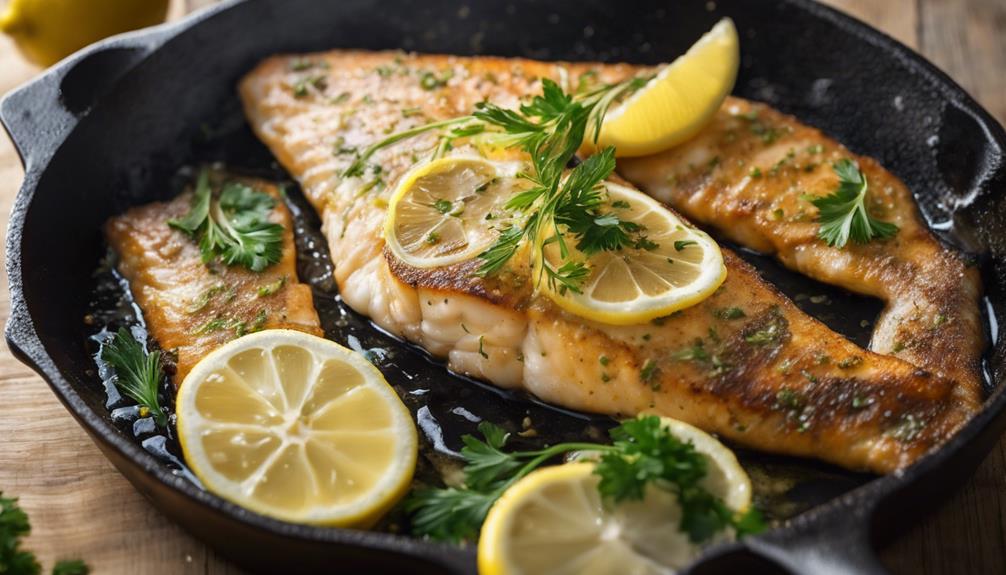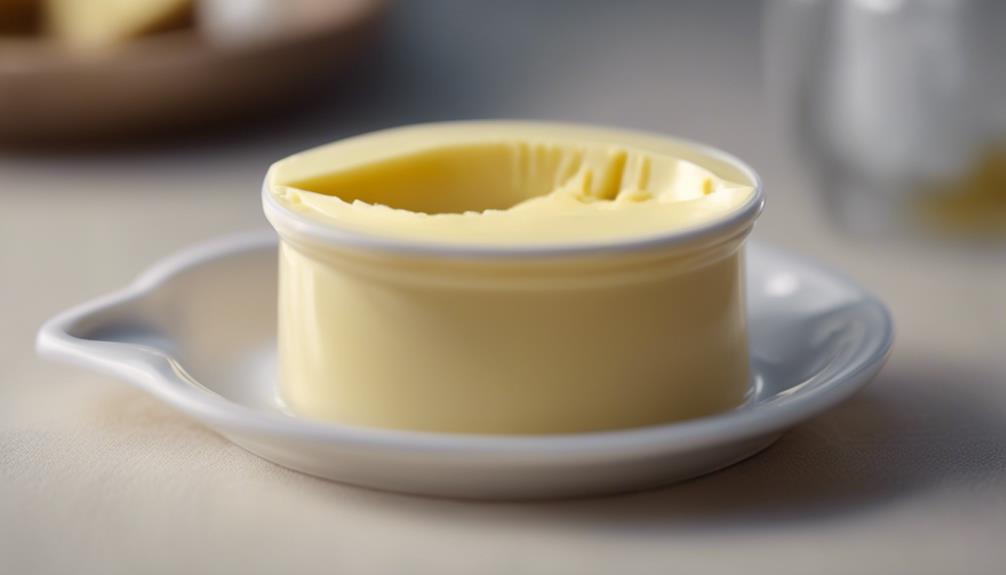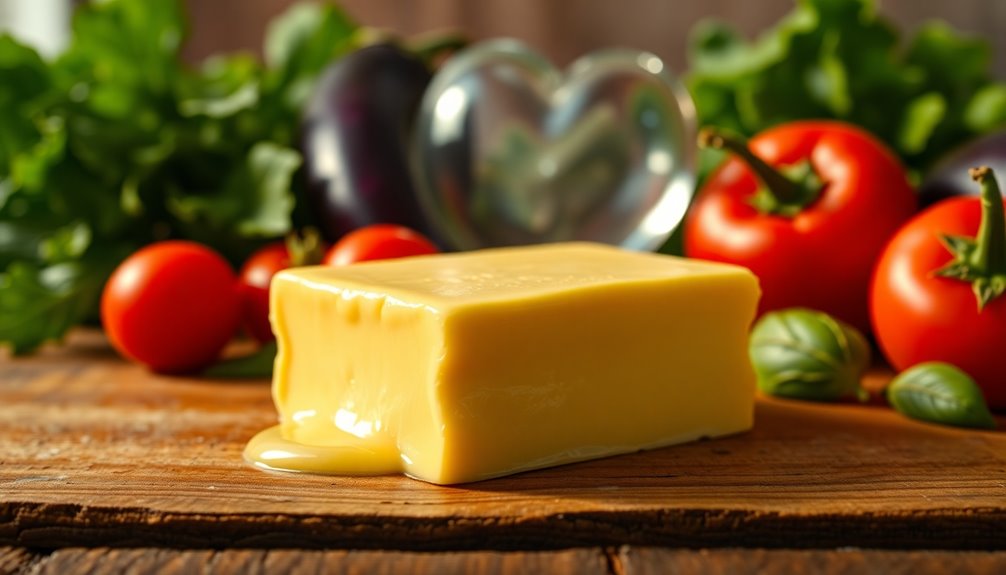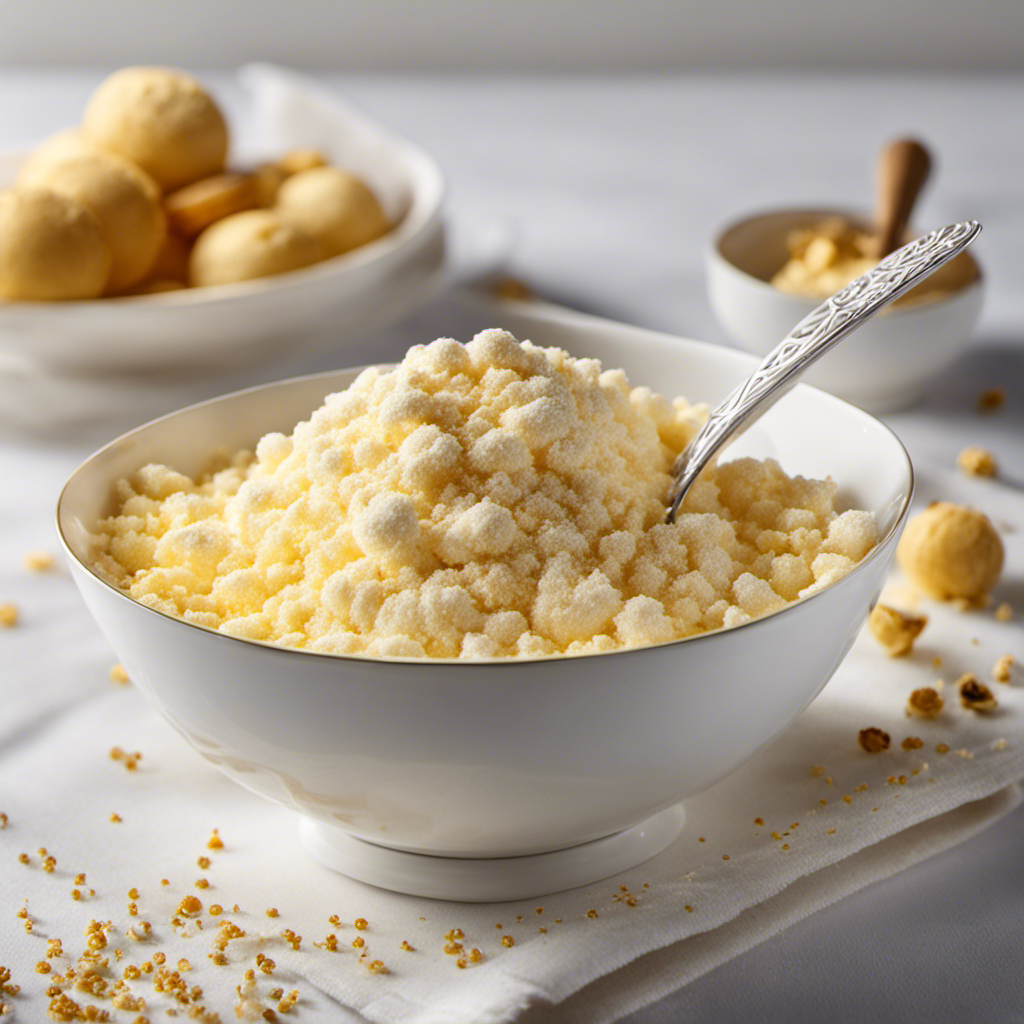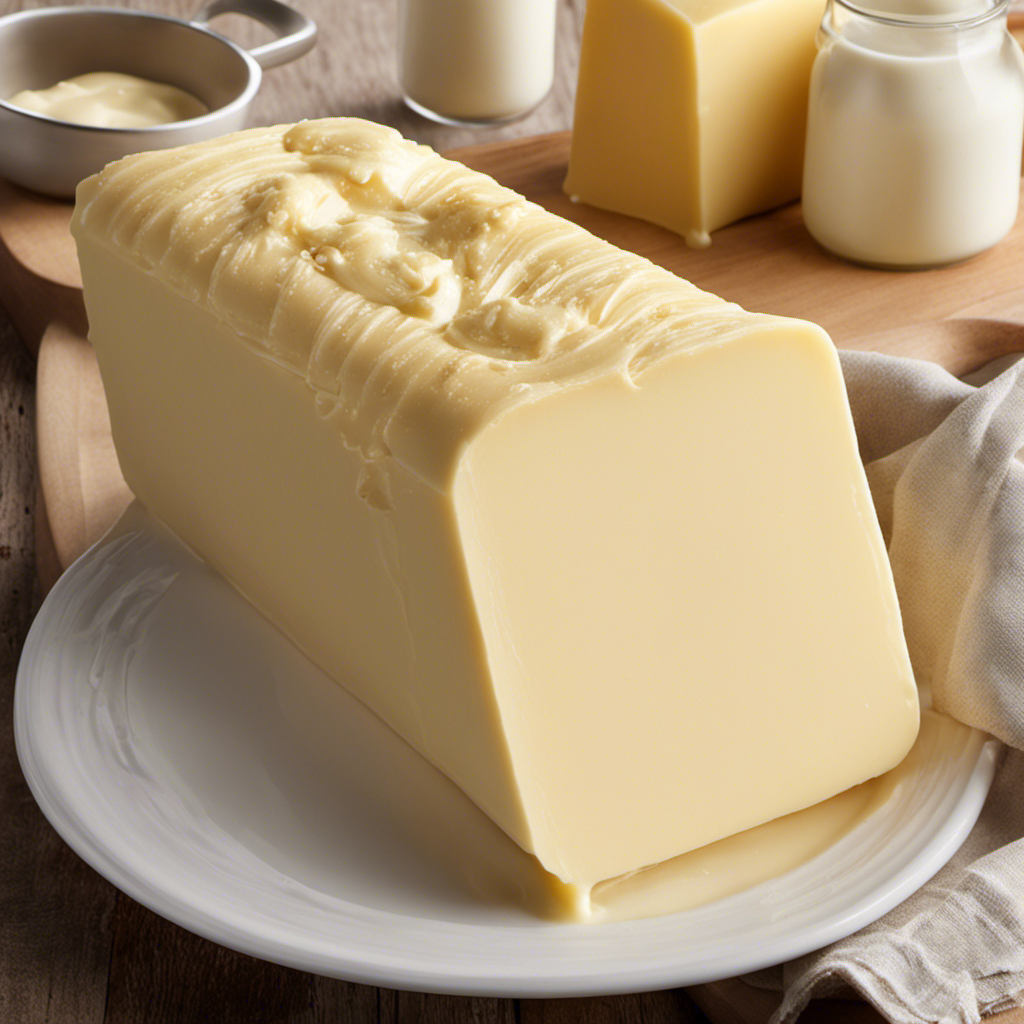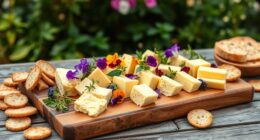To pan-fry haddock in butter perfectly, start by drying your fillets with a paper towel. Lightly coat them with a flour mixture seasoned with salt and pepper. Dip the fillets in beaten eggs or milk, then coat with breadcrumbs. Heat a high-quality pan over medium heat and melt a blend of butter and oil. Cook the haddock for 3-5 minutes per side until the edges are crispy and golden. Flip carefully to avoid splatters. Let the fillets rest for a moment before serving. For a delightful twist, pair with mashed potatoes or a fresh salad. There's more to discover about perfecting this dish!
Key Takeaways
- Thoroughly dry haddock fillets and season with salt, pepper, and lemon for enhanced flavor.
- Preheat the pan and melt a blend of butter and oil for optimal frying.
- Dredge fillets in seasoned flour, then cook 3-5 minutes per side until golden brown.
- Flip fillets carefully to avoid splatters and ensure even cooking.
- Let fillets rest briefly after cooking to retain moisture and achieve perfect texture.
Ingredients and Equipment
To pan fry haddock in butter, you'll need fresh haddock fillets and a high-quality frying pan like copper or cast iron. Fresh fillets are essential to achieving that perfect flaky texture and rich flavor. If you're using frozen haddock, make certain to thaw it completely to avoid excess moisture and guarantee even cooking.
A cast iron skillet is an excellent choice for this task because it distributes heat evenly and retains it well, giving you a beautifully cooked dish. Copper pans are also great for even heat distribution, though they require more maintenance.
Before you start cooking, gather your essential ingredients. You'll need flour, salt, and pepper. The flour helps to create a light, crispy coating on the fish when it's fried. Season the flour with salt and pepper to enhance the haddock's natural flavors.
Make sure your frying pan is preheated before adding any of the ingredients. A hot skillet guarantees that the fish cooks quickly and evenly, locking in moisture and flavor.
Preparing the Haddock
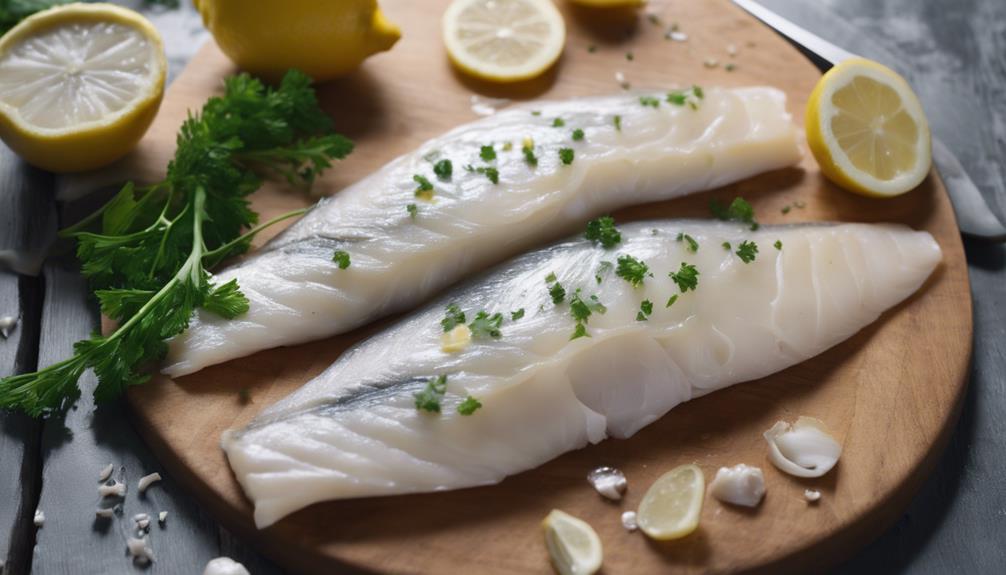
Before coating the haddock for pan frying, dry the fillets thoroughly with a paper towel to remove any excess moisture. This step is important because excess moisture can prevent the coating from sticking properly and can cause splattering when the fillets hit the hot pan.
Next, prepare a flour mixture to season the haddock fillets. Combine flour, a pinch of salt, and some freshly ground black pepper. You can add other seasonings like paprika or garlic powder if you prefer a more intricate flavor. Lightly dredge each fillet in this flour mixture, making sure they're evenly coated.
After that, dip the seasoned fillets into a shallow bowl containing either beaten eggs or milk. This step helps the breadcrumbs adhere better, giving your haddock that perfect crispy exterior.
Once dipped, coat the fillets with breadcrumbs, pressing gently to make sure they stick.
Cooking Method One
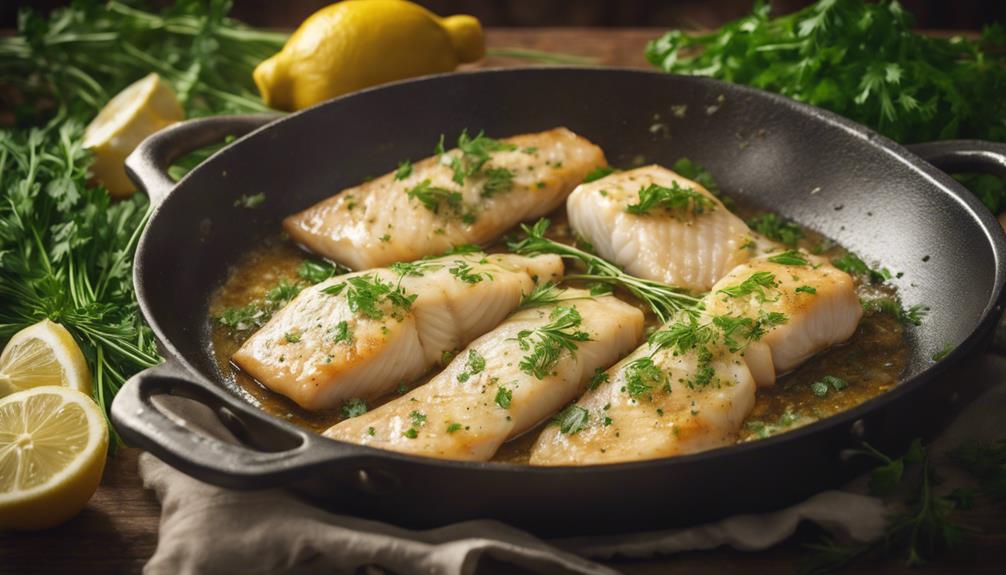
To start, coat your haddock fillets lightly with flour to give them a perfect crispy texture.
Next, season the fillets generously with salt and pepper.
Fry them in a hot pan with melted butter until they turn golden brown and deliciously crispy.
Flour Coating Technique
For a light and crispy texture on your pan-fried haddock, start by dredging the fillets in a mixture of flour, salt, and pepper. This simple flour coating method guarantees you'll achieve that crunchy crust everyone loves. The flour helps to create a golden brown exterior, which not only looks appealing but also adds a delightful crispiness to each bite.
First, prepare a shallow dish with flour, and season it generously with salt and pepper. Take each haddock fillet and lightly press it into the flour mixture, ensuring both sides are well-coated. Shake off any excess flour; you want a thin, even layer, not clumps. This coating technique helps lock in the natural juices of the haddock, keeping the fish moist and flavorful during the cooking process.
Once coated, your haddock fillets are ready for pan-frying. The flour coating not only adds texture but also helps the fish develop that perfect golden brown exterior when cooked in butter. This method is simple, requiring minimal ingredients and effort, yet it delivers a savory and satisfying meal that's both easy to prepare and enjoyable to eat.
Seasoning and Frying
Once your haddock fillets are coated, heat a skillet over medium heat and add a blend of butter and oil. This combination guarantees a rich flavor and prevents the butter from burning.
While the skillet heats up, season your haddock with a mixture of flour, salt, and pepper. Remember, the flour first approach helps create that crispy exterior everyone loves.
Next, dip the seasoned haddock fillets in milk or beaten egg. This step is essential for the flour mixture to adhere properly, resulting in a golden-brown crust during pan frying.
Carefully place the fillets into the hot skillet, making sure they sizzle on contact.
Cook the haddock for 3-5 minutes per side. You'll know it's time to flip when the edges look golden and crispy. Be gentle while turning to maintain the coating's integrity. Avoid overcooking to preserve the fish's delicate flavor and flaky texture.
Once both sides are perfectly crispy and the haddock is cooked through, remove the fillets from the skillet. Let them rest briefly on a paper towel to absorb any excess oil.
Serve immediately for the best flavor and texture. Enjoy your perfectly pan-fried haddock!
Cooking Method Two
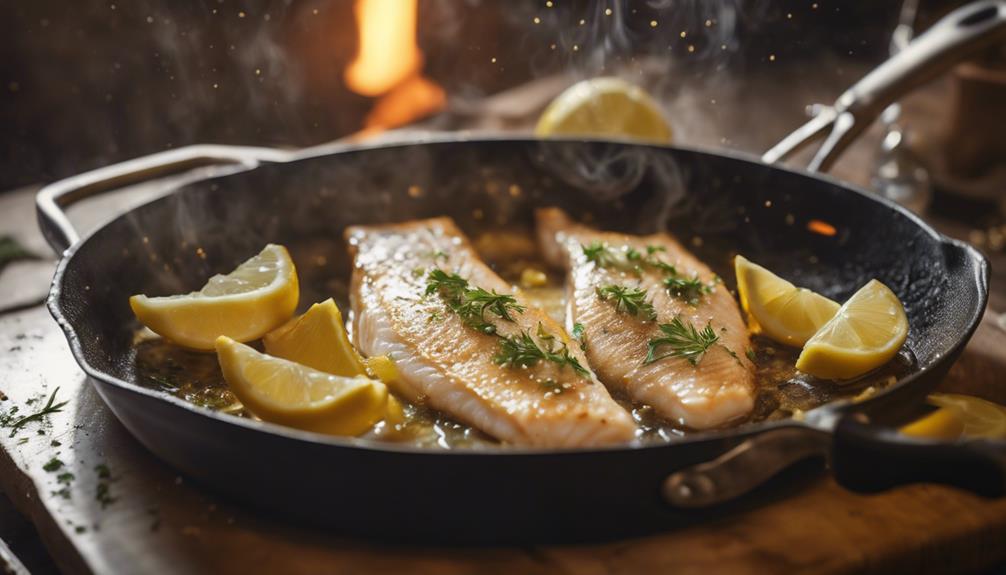
How do you achieve a perfectly crispy and flavorful haddock fillet using the pan fry method?
Start by coating your haddock fillet in seasoned flour. This creates a light, crispy exterior that locks in the fish's moisture and flavor.
Next, heat a combination of butter and oil in a skillet over medium-high heat. The butter adds a rich, savory flavor, while the oil helps prevent the butter from burning.
Once the skillet is hot, place the haddock fillet in the pan. Cook for 2-3 minutes per side, making sure each side becomes golden brown and crispy. Remember to flip the fillets away from you to avoid any hot oil splatters. This technique not only keeps you safe but also helps maintain the integrity of the fillet.
As the fish cooks, keep an eye on the heat to make sure the butter doesn't burn. Adjust the heat as necessary to keep the temperature steady.
When the fillets are cooked through and have a beautiful golden-brown crust, they're ready to be removed from the pan. Now you've got perfectly pan-fried haddock with a crispy exterior and rich buttery flavor, ready for serving!
Serving Suggestions
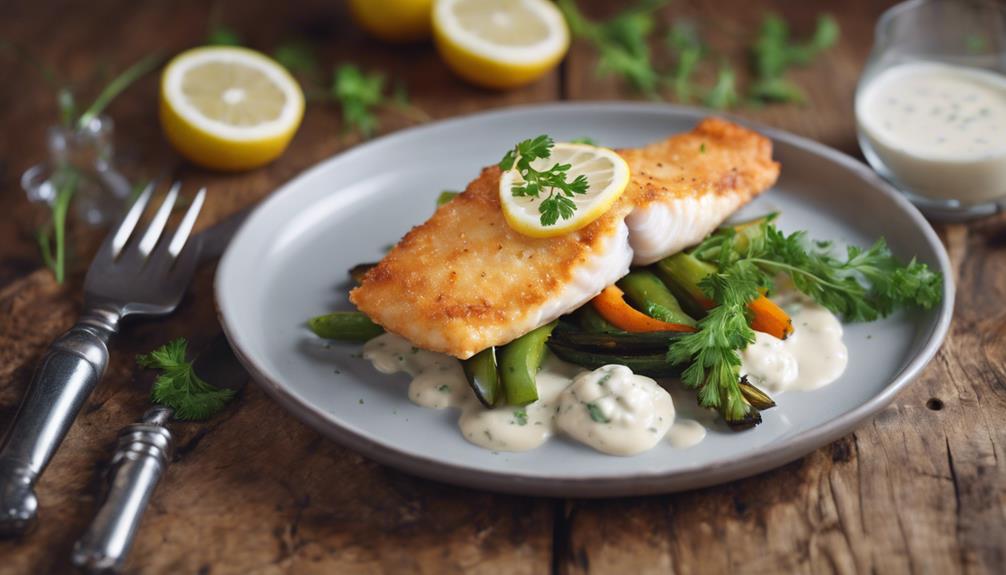
Now that your haddock fillets are perfectly crispy and golden, let's explore some delicious serving suggestions to complement your dish. Pan frying fresh haddock results in a delectable meal that can be paired with various sides to suit different tastes and occasions.
First, consider serving your fried haddock with a side of creamy mashed potatoes. This classic combination offers a comforting and hearty experience reminiscent of East Coast cuisine. Alternatively, if you're in the mood for something lighter, a fresh salad dressed with tangy vinaigrette can make for a rejuvenating contrast to the rich, buttery fish.
To elevate your haddock further, top it with a homemade tartar sauce. A blend of pickles, mayo, and lemon, this sauce adds zesty flavor that perfectly complements the crispy fillets. For a complete and balanced meal, pair your pan fried haddock with steamed vegetables like asparagus, green beans, or broccoli. Finally, a simple squeeze of fresh lemon over the fish can provide a burst of citrus that brightens the overall dish.
Here's a quick guide to enhance your fried haddock meal:
| Main Dish | Side Option 1 | Side Option 2 |
|---|---|---|
| Fried Haddock | Mashed Potatoes | Fresh Salad with Vinaigrette |
| Homemade Tartar Sauce | Steamed Vegetables | |
| Squeeze of Lemon |
These serving suggestions will guarantee your haddock dish is both flavorful and satisfying.
Adaptations for Other Fish
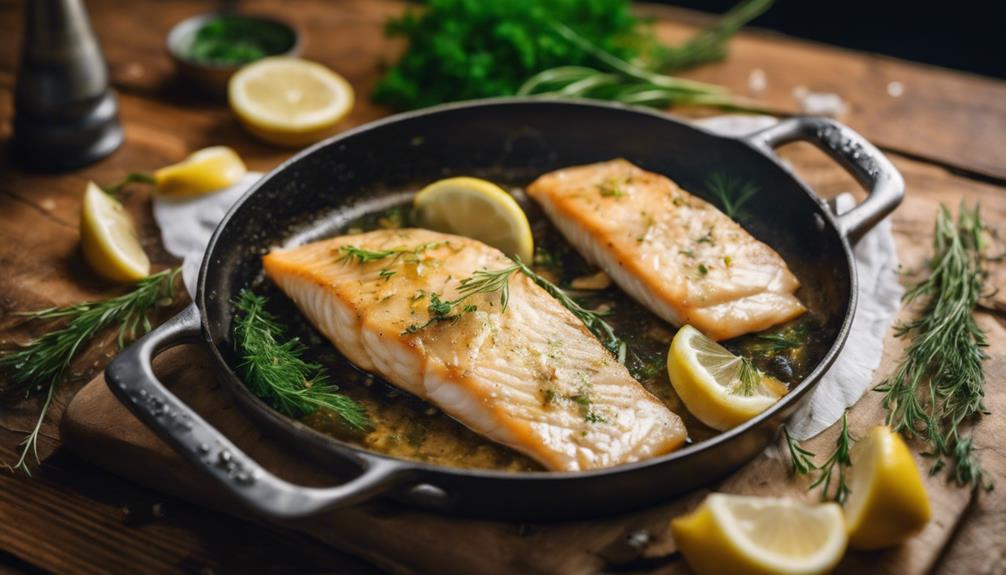
Adapting the pan-fried haddock recipe for other fish like halibut, salmon, tilapia, trout, and hake is a simple way to diversify your seafood dishes. You'll find that each type of fish brings its own unique flavor and texture. Start by experimenting with different types to discover your favorite combinations.
For example, halibut and salmon have a firmer texture compared to haddock, so you might need to adjust the cooking temperature and duration to prevent overcooking.
When you try these modifications for other fish, remember to adjust seasonings and cooking times. Thicker fish like halibut and salmon can handle stronger seasonings and might require a bit more time in the pan. Conversely, delicate fish like tilapia and trout cook quickly and need a gentler touch with seasonings.
Exploring a variety of fish options guarantees your seafood dishes remain exciting and flavorful. Keep an eye on the fish while cooking, as different varieties may need slight modifications in temperature and duration. By being attentive and willing to experiment, you'll master the art of pan-frying a range of fish, each perfectly suited to its unique character.
Frequently Asked Questions
How Long Does It Take to Pan-Fry Haddock?
Pan-frying haddock takes about 3-5 minutes per side, depending on the thickness of the fillets. Make sure your pan is hot and use a mix of butter and oil to get that perfect golden-brown crust.
What Is the Best Cooking Technique for Haddock?
To cook haddock perfectly, use a combination of butter and oil for pan frying. This technique gives the fish a crispy exterior, keeps it moist inside, and enhances its natural flavors without overpowering them.
Do You Pan-Fry Fish in Oil or Butter?
You can pan-fry fish in oil or butter. Oil prevents burning; butter adds flavor. Combining both achieves a crispy, flavorful result. Monitor the heat carefully to avoid burning the butter while still getting that rich taste.
How Long to Cook Fish in a Pan?
Cook fish fillets for about 3-5 minutes per side in a pan. Adjust the time based on thickness, and guarantee the internal temperature reaches 145°F. Don't overcook to keep the fish moist and flavorful.
Conclusion
With these simple steps, you've mastered the art of pan-frying haddock in butter. Your kitchen's now a haven of delicious aromas, and your taste buds are dancing with delight. It's not just a meal; it's an experience.
So go ahead, serve your perfectly cooked haddock with pride. And remember, this technique works wonders on other fish too. Immerse yourself in this culinary adventure, and let the flavors whisk you away on a sea of satisfaction.
Enjoy every bite!
